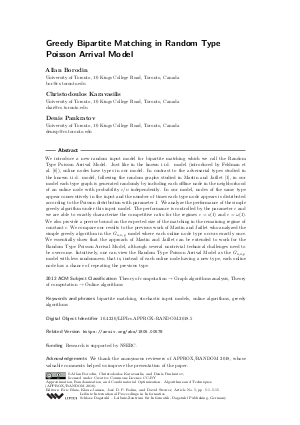Greedy Bipartite Matching in Random Type Poisson Arrival Model
Authors Allan Borodin, Christodoulos Karavasilis, Denis Pankratov
-
Part of:
Volume:
Approximation, Randomization, and Combinatorial Optimization. Algorithms and Techniques (APPROX/RANDOM 2018)
Part of: Series: Leibniz International Proceedings in Informatics (LIPIcs)
Part of: Conference: International Conference on Randomization and Computation (RANDOM)
Part of: Conference: International Conference on Approximation Algorithms for Combinatorial Optimization Problems (APPROX) - License:
 Creative Commons Attribution 3.0 Unported license
Creative Commons Attribution 3.0 Unported license
- Publication Date: 2018-08-13
File

PDF
LIPIcs.APPROX-RANDOM.2018.5.pdf
- Filesize: 0.65 MB
- 15 pages
Document Identifiers
Related Versions
Subject Classification
ACM Subject Classification
- Theory of computation → Graph algorithms analysis
- Theory of computation → Online algorithms
Keywords
- bipartite matching
- stochastic input models
- online algorithms
- greedy algorithms
Metrics
- Access Statistics
-
Total Accesses (updated on a weekly basis)
0PDF Downloads0Metadata Views
Abstract
We introduce a new random input model for bipartite matching which we call the Random Type Poisson Arrival Model. Just like in the known i.i.d. model (introduced by Feldman et al. [Feldman et al., 2009]), online nodes have types in our model. In contrast to the adversarial types studied in the known i.i.d. model, following the random graphs studied in Mastin and Jaillet [A. Mastin, 2013], in our model each type graph is generated randomly by including each offline node in the neighborhood of an online node with probability c/n independently. In our model, nodes of the same type appear consecutively in the input and the number of times each type node appears is distributed according to the Poisson distribution with parameter 1. We analyze the performance of the simple greedy algorithm under this input model. The performance is controlled by the parameter c and we are able to exactly characterize the competitive ratio for the regimes c = o(1) and c = omega(1). We also provide a precise bound on the expected size of the matching in the remaining regime of constant c. We compare our results to the previous work of Mastin and Jaillet who analyzed the simple greedy algorithm in the G_{n,n,p} model where each online node type occurs exactly once. We essentially show that the approach of Mastin and Jaillet can be extended to work for the Random Type Poisson Arrival Model, although several nontrivial technical challenges need to be overcome. Intuitively, one can view the Random Type Poisson Arrival Model as the G_{n,n,p} model with less randomness; that is, instead of each online node having a new type, each online node has a chance of repeating the previous type.
Cite As Get BibTex
Allan Borodin, Christodoulos Karavasilis, and Denis Pankratov. Greedy Bipartite Matching in Random Type Poisson Arrival Model. In Approximation, Randomization, and Combinatorial Optimization. Algorithms and Techniques (APPROX/RANDOM 2018). Leibniz International Proceedings in Informatics (LIPIcs), Volume 116, pp. 5:1-5:15, Schloss Dagstuhl – Leibniz-Zentrum für Informatik (2018)
https://doi.org/10.4230/LIPIcs.APPROX-RANDOM.2018.5
BibTex
@InProceedings{borodin_et_al:LIPIcs.APPROX-RANDOM.2018.5,
author = {Borodin, Allan and Karavasilis, Christodoulos and Pankratov, Denis},
title = {{Greedy Bipartite Matching in Random Type Poisson Arrival Model}},
booktitle = {Approximation, Randomization, and Combinatorial Optimization. Algorithms and Techniques (APPROX/RANDOM 2018)},
pages = {5:1--5:15},
series = {Leibniz International Proceedings in Informatics (LIPIcs)},
ISBN = {978-3-95977-085-9},
ISSN = {1868-8969},
year = {2018},
volume = {116},
editor = {Blais, Eric and Jansen, Klaus and D. P. Rolim, Jos\'{e} and Steurer, David},
publisher = {Schloss Dagstuhl -- Leibniz-Zentrum f{\"u}r Informatik},
address = {Dagstuhl, Germany},
URL = {https://drops.dagstuhl.de/entities/document/10.4230/LIPIcs.APPROX-RANDOM.2018.5},
URN = {urn:nbn:de:0030-drops-94098},
doi = {10.4230/LIPIcs.APPROX-RANDOM.2018.5},
annote = {Keywords: bipartite matching, stochastic input models, online algorithms, greedy algorithms}
}
Author Details
Funding
Research is supported by NSERC.
References
- P. Jaillet A. Mastin. Greedy online bipartite matching on random graphs, 2013. URL: https://arxiv.org/abs/1307.2536v1.
-
M. Zadimoghaddam B. Haeupler, V.S. Mirrokni. Online stochastic weighted matching: Improved approximation algorithms, WINE 2011.

-
Bert Besser and Matthias Poloczek. Greedy matching: Guarantees and limitations. Algorithmica, 77(1):201-234, 2017.

-
Bela Bollobás and Graham Brightwell. The width of random graph orders. The Mathematical Scientist, 20, 01 1995.

-
Allan Borodin, Christodoulos Karavasilis, and Denis Pankratov. An experimental study of algorithms for online bipartite matching, Unpublished work in progress, 2018.

-
Jon Feldman, Aranyak Mehta, Vahab Mirrokni, and S. Muthukrishnan. Online stochastic matching: Beating 1-1/e. In Proc. of FOCS, pages 117-126, 2009.

-
Gagan Goel and Aranyak Mehta. Online budgeted matching in random input models with applications to adwords. In Proc. of SODA, pages 982-991, 2008.

-
Carl W. Helstrom. Statistical Theory of Signal Detection (Second Edition, Revised and Enlarged). International Series of Monographs in Electronics and Instrumentation. Pergamon, second edition, revised and enlarged edition, 1968.

-
Patrick Jaillet and Xin Lu. Online stochastic matching: New algorithms with better bounds. Mathematics of Operations Research, 39(3):624-646, 2014.

-
R. M. Karp, U. V. Vazirani, and V. V. Vazirani. An optimal algorithm for on-line bipartite matching. In Proc. of STOC, pages 352-358, 1990.

-
Jon M. Kleinberg. Bursty and hierarchical structure in streams. Data Min. Knowl. Discov., 7(4):373-397, 2003.

-
Thomas G. Kurtz. Solutions of ordinary differential equations as limits of pure jump markov processes. Journal of Applied Probability, 7(1):49-58, 1970.

-
A. Mehta. Online matching and ad allocation, Theoretical Computer Science, 8(4):265–368, 2012.

- Gordon Simons and N. L. Johnson. On the convergence of binomial to poisson distributions. Ann. Math. Statist., 42(5):1735-1736, 10 1971. URL: http://dx.doi.org/10.1214/aoms/1177693172.
-
Kannikar Siriwong, Lester Lipsky, and Reda A. Ammar. Study of bursty internet traffic. In Sixth IEEE International Symposium on Network Computing and Applications (NCA 2007), 12 - 14 July 2007, Cambridge, MA, USA, pages 53-60, 2007.

- Stats Stackexchange. What is the expectation of the absolute value of the skellam distribution? https://stats.stackexchange.com/questions/279220/what-is-the-expectation-of-the-absolute-value-of-the-skellam-distribution. Accessed: 2018-04-11.
-
A. Saberi V. H. Manshadi, S. Oveis Gharan. Online stochastic matching: Online actions based on offline statistics, Mathematics of Operations Research, 37(4):559-573, 2012.

-
Nicholas C. Wormald. Differential equations for random processes and random graphs. Ann. Appl. Probab., 5(4):1217-1235, 11 1995.

-
Nicholas C. Wormald. The differential equation method for random graph processes and greedy algorithms. In Lectures on approximation and randomized algorithms, pages 73-155, 1999.

